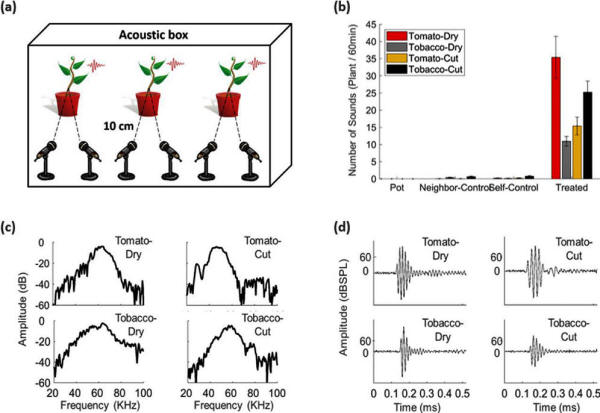|

by Manuel García Aguilar
December
06, 2019
from
TheMindUnleashed Website
Similar spanish version

Plants make
sounds
at frequencies
humans cannot hear
when facing
situations such as
lack of water or
being cut...
New research shows that
plants can actually talk.
But don't expect them to help you with your homework or sing along
with the radio. A new study shows that plants are creating
frequencies in responses to their surroundings, or in other words,
they are reacting...
These "reactions" in plants, that we could see as analogical to
human senses, is actually nothing new. We have learned over the past
few years that plants are capable of,
seeing, hearing, and
smelling...
And with this newest
finding we are just one sense away from completing the five human
senses in some species of the plantae kingdom.
For the first time, plants have been
recorded making airborne sounds
when stressed, which researchers say could open up a new field of
precision agriculture where farmers listen for water starved crops.
This study was done by Itzhak Khait and his colleagues at Tel
Aviv University in Israel.
The researchers found
that tomato and tobacco plants made sounds at frequencies humans
cannot hear when facing situations such as lack of water or when
being cut.
Khait
explained:
"To investigate
plants' airborne sound emissions, we first constructed a
reliable recording system, in which each plant was recorded
simultaneously with two microphones within an acoustically
isolated
anechoic box.
We recorded tomato (Solanum
lycopersicum) and tobacco (Nicotiana tabacum) plants under
different treatments - drought stress, cutting (of the stem),
and controls.
We focused on the
ultrasonic sound range (20-150 kHz), where the background noise
is weaker"
Plants emit Informative Airborne Sounds under Stress

On average,
drought-stressed tomato plants made 35 sounds per hour, while
tobacco plants made 11 and unstressed plants produced fewer than one
sound per hour, on average.
The researchers trained a machine-learning model to discriminate
between the plant's sounds and the wind, rain, and other ambient
noises of the greenhouse, in order to correctly identify the source
of stress.
"After we succeeded
filtering greenhouse noises, we could use 'clean' plant sounds
to classify plant condition in the greenhouse.
Results from the
acoustic box recordings showed that drought-stressed plants
emitted significantly more sounds than control plants"
Sound exists in both low
and high frequencies.
Humans cannot hear the
entire spectrum of frequencies around us. If we could, we would
likely become distracted and anxious by always hearing the
frequencies around us including radio frequencies from cell towers
near us or even cooking a frozen meal in the microwave.
Thankfully, the range of
human hearing is typically considered to be only 20 Hz to 20 kHz.
With the above in mind, we can now understand why humans are not
sensitive to the sounds that plants are emitting.
A possible mechanism by which they generate the sounds is
cavitation (the process whereby air
bubbles form and explode in the
xylem):
"Cavitation
explosions have been shown to produce vibrations similar to the
ones we recorded... but it has never been tested whether these
sounds are transmitted through air at intensities that can be
sensed by other organisms.
Regardless of the
specific mechanism generating them, the sounds we record carry
information, and can be heard by many organisms.
If these sounds serve
for communication a plant could benefit from, natural selection
could have favored traits that would increase their
transmission."
Further research must be
conducted to find the potential applications this discovery may
have, but these are big steps to understanding the reality of the
plants that surround us.
| 


